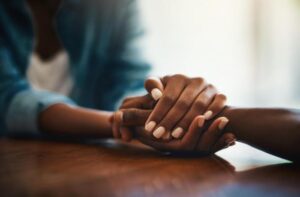
www.shutterstock.com
As a Clinical Pastoral Educator working with adult learners, in a metropolitan Level I Trauma Center, I am committed to providing a curriculum that is robust enough to prepare them for professional ministry. The clinical milieu at Atlanta Medical Center provides a plethora of opportunities for students to learn in relationship with patients, families, staff, peers, administrators, and educators, while engaging in an interactive transformational learning experience. To train them for professional ministry, in a world that requires them to be steady, calculated, and creative, I’ve found that the students who are willing to invest the time, dedicate themselves to learning, be self-reflective, remain open to critique and those who can tolerate some degree of vulnerability have the most successful outcomes.
How do chaplains do it?
Often people will say to chaplains, “I don’t know how you do it. I don’t understand how you are able to be with people when they are in deep crisis. I couldn’t do it.” These are not statements that you can respond to in a few short sentences. What those people are bearing witness to is someone who has put the work in and acquired the skillset to be with others in their pain and suffering because the chaplain has confronted his own pain and suffering. How does this happen? Although it is not simple, the simple answer is that the student has tapped into his own sources of hope and despair.
Entering into your experience through my experience
“Code 1, ETA 5 minutes” rings out three times across the intercom of the hospital. Seconds later the pager goes off, and it reads, Level 1 Trauma GSW, 16-y.o. male. Immediately, I abandoned my lunch, and in a flash, I moved anxiously towards the Emergency Department. Knowing nothing about the circumstances of the situation, I thought “I wonder if he’s dead? What’s the story? I can’t take another GSW tonight. The last one was so emotional, I’m not sure I’m ready to go through this again.” This chaplain is all too familiar with gun violence, as he grew up in a community overrun with extreme violence. He has his own story of losing a loved one to a drive-by shooting.
The phone rings and the voice on the line asks for a chaplain. The intern student acknowledges, “I am the chaplain on call.” The caller proceeds by saying, “We need you to come and be with a family who has just lost their mother. People are screaming and falling out on the floor, and we need help!” On the way the chaplain attempts to imagine herself as a calming presence. She begins to practice breathing exercises as she walks toward the unit. Having just lost her mother a month ago, how will she react?

www.pixstory.com
Two cars collided on I-85 North, coming into the city. One car was flipped on its top and the driver and another passenger were badly wounded. The third passenger was thrown out of the car, landing onto the highway near the guard rail, but was still breathing with severe head trauma. The driver in the second car was also injured but was able to walk away without serious injuries. All the passengers were brought to the hospital and the chaplain was called upon to assist with making phone calls to family members to break the news. “For a moment, I was frozen in my tracks”, stated the intern chaplain. “This was too familiar.” “So scared, I wasn’t sure if I could do this.” Ten years ago, he had a similar experience where his car flipped, and he was seriously injured.
The Wounded and the Healer
Henri Nouwen, author of The Wounded Healer, writes: “Our service will not be perceived as authentic unless it comes from a heart wounded by the suffering about which we speak”[1]. In my experience as a CPE educator, I have found that the journey and life experiences that students have encountered prior to (and during) CPE become useful material enabling them to confront and meet the challenges that this process learning approach provides. The image of the wounded healer resonates with me because it is through the journey of God healing my wounds that has provided the empathy and compassion for those whom I serve and teach.
Compassion is the key
So, what’s the role of the educator in all of this? Are these just stories to tell? Why do they even matter? In my one-on-one time with students, their stories of survival, pain, disappointment, abandonment, etc. become a part of our conversations as they reflect on the memories that were triggered through their clinical work with patients, families, and staff. It’s amazing how a care recipient’s current experience can mirror and awaken the student’s personal experience and trigger a reaction or particular response. Sometimes the student’s pain and wounds are very deep, requiring lots of time and patience on my behalf. Compassion is the key, and I have lots of compassion. Yes, my heart aches with them while through the action-reflection-action process model of learning they re-examine the challenges of their past, determine how they are informed out of their personal experiences to care for others, while considering new and different ways of making meaning of their past situation for their own growth. A major goal for me is to provide a safe context in which students can process their thoughts, feelings, and emotions and find the beauty in their brokenness as they increase in self-awareness.
Whether it is recalling the major life event of having twins in her 20s as a single mom and going through great emotional physical and financial stress that moves upon the student to have empathy and support for those moms who have been marginalized and ostracized by others; or finding the words to console a new father who has just received news that his newborn son is dying of some rare disease, after losing your own teenaged son to a fatal car crash caused by a drunk driver, CPE students have a lot to bring to the learning process. They not only bring their sadness, but their joys and I get to be a part of their story, even if it’s just to have someone with whom they can process the experience.
Suggested Reading:
Nouwen, Henri J. M. The Wounded Healer. New York: Image Books Doubleday, 1972
Rogers, Carl. On Becoming A Person. Boston, MA: Houghton Mifflin Company, 1961
Rogers, Frank. Practicing Compassion. Nashville, TN: Upper Room, 2015.
[1] Nowen, The Wounded Healer, xvi